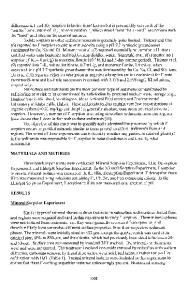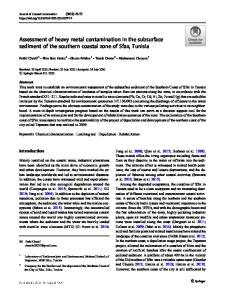Distribution of heavy and clay minerals in coastal sediment of Jijel, East of Algeria: indicators of sediment sources an
- PDF / 7,296,125 Bytes
- 18 Pages / 595.276 x 790.866 pts Page_size
- 60 Downloads / 367 Views
ORIGINAL PAPER
Distribution of heavy and clay minerals in coastal sediment of Jijel, East of Algeria: indicators of sediment sources and transport and deposition environments Saci Kermani 1 & Makhlouf Boutiba 1 & Abdelhak Boutaleb 2 & Nathalie Fagel 3
Received: 30 March 2015 / Accepted: 29 September 2015 # Saudi Society for Geosciences 2015
Abstract The identification of bulk, clay (40 μm) was dried, weighed, and sieved through a series of sieves 2000 to 40 μm mesh, installment following the AFNOR standard. The results from sieving where then used to calculate the percentage weight per Wentworth (phi) scale (Φ=−log2D (mm)) and to calculate, three grain-size indices; the mean grain size (μz), standard deviation (Φi), and index of asymmetry (Ski) according to Falk and Ward (1957) for each sample. Mineralogical analysis The mineralogical analyses are to determine the qualitative and semi-quantitative mineralogical distribution of sediment arriving on the coast sedimentary stocks. Studied among these analyses was an analysis of the bulk, clay, and heavy mineral fractions. In total, 16 representative samples have been selected for the bulk and clay minerals analyses by X-ray diffraction. For the bulk mineralogy, 1 g of the crude sample sieved to 250 μm, installed on a sample holder compacted carefully and regularly in order to limit any preferential orientation of minerals (method of Moore and Reynolds 1989). Semi-quantitative assessment was obtained by applying correction factors to the measured intensities of reflections of diagnostic mineral. Clay minerals analyses were recorded from oriented aggregates on the glass slide (Moore and Reynolds 1989) and were prepared from the fraction 1.73 φ is located at the coast at a distance less than 150 m from the shoreline. In this area, sediment transfer direction can be determined from the gradient of the average grain size: oversized >1.73 φ at the mouth of the wadi Mencha and East from the mouth of Djen djen opposes the lowest values in the East of the port of Jijel. If we feel that the sediment transfer is carried
Arab J Geosci Table 2 Sediment particle size parameters of Jijelian coast sedimentary environments
Sectors
Sample codes
Longitude (ρ)
Latitude (λ)
Mean « UZ »
Skewness « Ski »
Storing « Φi »
Nil wadi
O.N.1 O.N.2
36.827921 36.821808
5.937990 5.936321
1.20 1.94
−0.11 0.08
0.71 0.91
O.N.3
36.773967
5.929101
2.61
0.22
1.08
O.N.4 O.D.1
36.747500 36.813144
5.941300 5.855452
2.21 1.92
−0.11 0.16
0.74 0.95
O.D.2 O.D.3
36.811029 36.805044
5.864201 5.863136
2.17 0.94
−0.03 0.09
0.73 0.63
O.D.4
36.755655
5.863136
2.96
0.32
0.98
O.D.5 O.E.K.1
36.628500 36.870700
5.797300 6.086700
2.31 2.74
−0.25 0.22
0.55 0.67
O.E.K.2
36.832300
6.133700
2.49
0.02
0.84
O.E.K.3
36.806314
6.169399
2.27
0.01
0.85
O.E.K.4 O.E.K.5 O.E.K.6 O.M.1
36.725599 36.636468 36.602465 36.807900
6.260924 6.276812 6.281557 5.821500
0.78 0.30 1.02 1.59
−0.17 −0.03 −0.21 0.00
1.46 1.46 0.74 0.87
O.M.2 O.M.3 E.P.1
36.803319 36.771302 36.892105
5
Data Loading...











